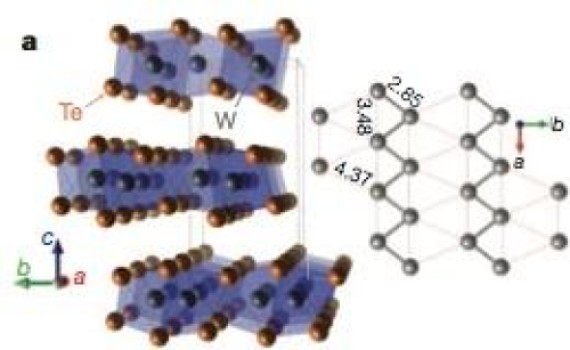It looks like you're using an Ad Blocker.
Please white-list or disable AboveTopSecret.com in your ad-blocking tool.
Thank you.
Some features of ATS will be disabled while you continue to use an ad-blocker.
8
share:
((Did a search and got no results))

This image shows the crystal structure of WTe2.
They wanted to name it "ludicrous" magnetoresistance in tribute to Mel Brook's "ludicrous speed" in the movie "Spaceballs" and even gave Mel Brooks acknowledgement in the article but other lab members sucked and vetoed it. They tried again for "Titanic" magnetoresistance but the Nature editors didn't like that and "steered" them towards "large" magnetoreistance.
A great breakthrough and I can't wait to see it applied to technology

This image shows the crystal structure of WTe2.
Unstoppable magnetoreistance
Ali applied a magnetic field to a sample of WTe2, one way to kill superconductivity if present, and saw that its resistance doubled. Intrigued, Ali worked with Jun Xiong, a student in the laboratory of Nai Phuan Ong, the Eugene Higgins Professor of Physics at Princeton, to re-measure the material's magnetoresistance, which is the change in resistance as a material is exposed to stronger magnetic fields.
"He noticed the magnetoresistance kept going up and up and up -- that never happens." said Cava. The researchers then exposed WTe2 to a 60-tesla magnetic field, close to the strongest magnetic field humans can create, and observed a magnetoresistance of 13 million percent. The material's magnetoresistance displayed unlimited growth, making it the only known material without a saturation point. The results were published on September 14 in the journal Nature
Electronic information storage is dependent on the use of magnetic fields to switch between distinct resistivity values that correlate to either a one or a zero. The larger the magnetoresistance, the smaller the magnetic field needed to change from one state to another, Ali said. Today's devices use layered materials with so-called "giant magnetoresistance," with changes in resistance of 20,000 to 30,000 percent when a magnetic field is applied. "Colossal magnetoresistance" is close to 100,000 percent, so for a magnetoresistance percentage in the millions, the researchers hoped to coin a new term.
They wanted to name it "ludicrous" magnetoresistance in tribute to Mel Brook's "ludicrous speed" in the movie "Spaceballs" and even gave Mel Brooks acknowledgement in the article but other lab members sucked and vetoed it. They tried again for "Titanic" magnetoresistance but the Nature editors didn't like that and "steered" them towards "large" magnetoreistance.
A great breakthrough and I can't wait to see it applied to technology
edit on 9-10-2014 by knoledgeispower because: (no reason given)
Great post. Does anyone have any ideas what other applications it might have besides computer applications? It does seem to be a major breakthrough
in the properties of materials but I'm at a loss to know where it might be useful. My best,
a reply to: airforce47
All I can think of is a sound system, using this magnetism to cancel out extra frequencies. With no saturation point, this would be best in a subwoofer, as bass can get really muddy/ugly really fast.
All I can think of is a sound system, using this magnetism to cancel out extra frequencies. With no saturation point, this would be best in a subwoofer, as bass can get really muddy/ugly really fast.
a reply to: Lynk3
The original article on physics
m.phys.org...
Says that it could make for better scanners
I'm thinking emp protection materials
The original article on physics
m.phys.org...
Says that it could make for better scanners
I'm thinking emp protection materials
a reply to: Lynk3
I am just guessing but I would think there could be some safety application in housing rail guns, or stealth(hiding electronic signatures).
I just wanted to add this really cool link for all kinds of questions regarding magnetic fields/gravity.
helios.gsfc.nasa.gov...
I am just guessing but I would think there could be some safety application in housing rail guns, or stealth(hiding electronic signatures).
I just wanted to add this really cool link for all kinds of questions regarding magnetic fields/gravity.
helios.gsfc.nasa.gov...
edit on 10-10-2014 by QuietSpeech because:
added content
new topics
-
Ed Dowd some good news
Medical Issues & Conspiracies: 4 hours ago -
Anyone like the Scorpions?
Music: 5 hours ago -
What if this is true?
2024 Elections: 5 hours ago -
Merry-Go-Round Ride
Short Stories: 7 hours ago -
It's toast
General Chit Chat: 11 hours ago
top topics
-
A fix for the Trans players in sports
Social Issues and Civil Unrest: 14 hours ago, 16 flags -
What if this is true?
2024 Elections: 5 hours ago, 12 flags -
Man Stabbed or Cardiac arrest on Westminster Bridge, London, UK
Mainstream News: 13 hours ago, 7 flags -
It's toast
General Chit Chat: 11 hours ago, 7 flags -
Ed Dowd some good news
Medical Issues & Conspiracies: 4 hours ago, 6 flags -
Merry-Go-Round Ride
Short Stories: 7 hours ago, 5 flags -
Anyone like the Scorpions?
Music: 5 hours ago, 3 flags
8
